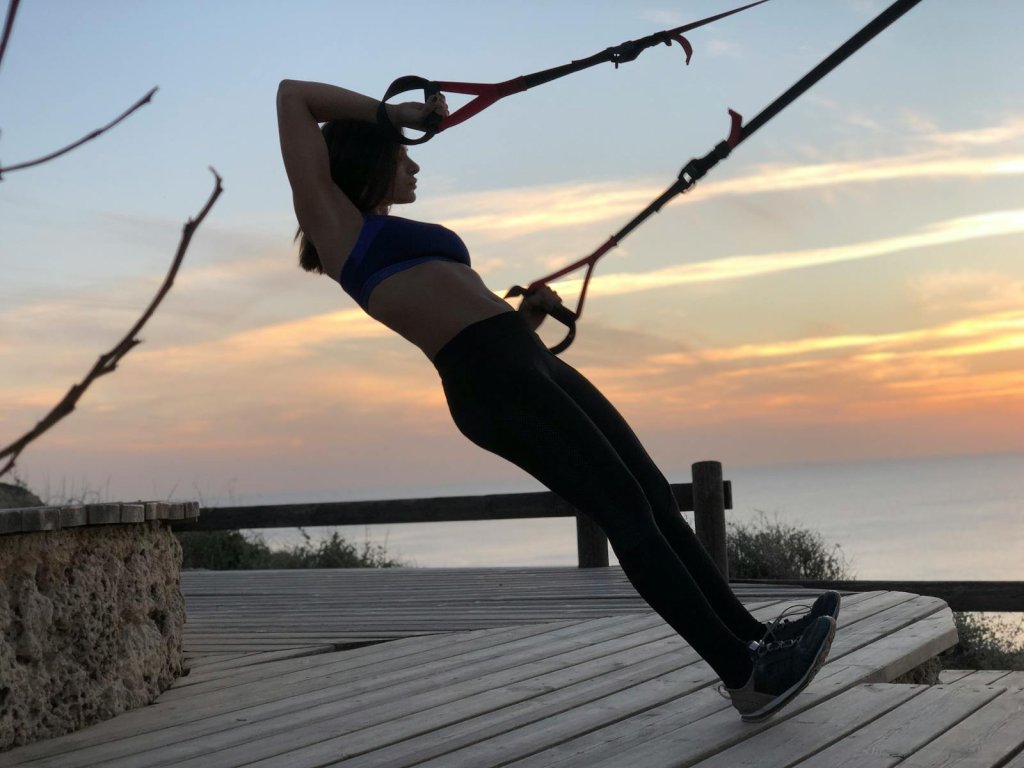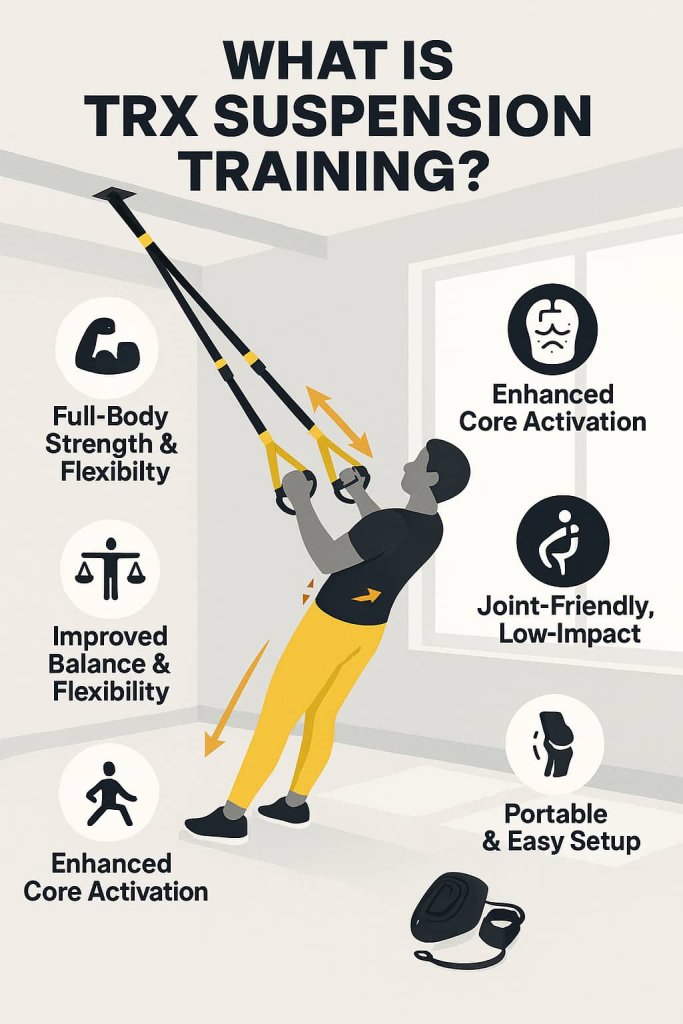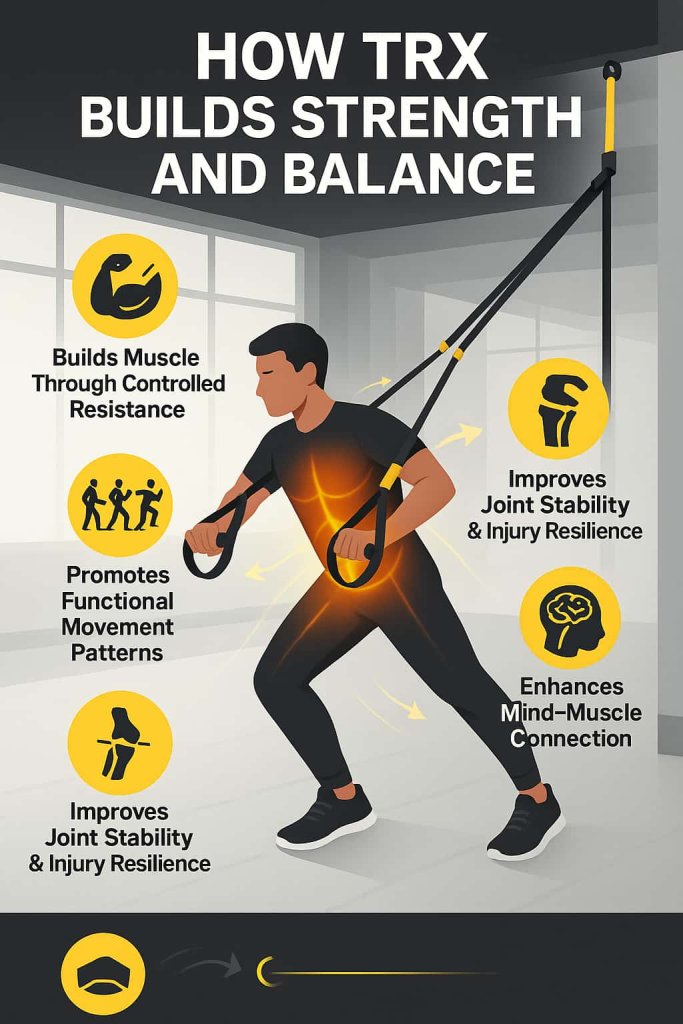TRX workouts are one of the most effective ways to build full-body strength, balance, and core stability — all with just a pair of suspension straps.
Developed by U.S. Navy SEAL Randy Hetrick, the Total Resistance Exercise (TRX) system uses gravity and your own body weight to challenge muscles through every plane of motion.

This form of functional training is perfect for anyone looking to improve mobility, strength, and endurance — at home, the gym, or even outdoors. TRX helps you engage multiple muscle groups at once, making your workouts efficient, low-impact, and adaptable for any fitness level.
Whether you’re a beginner or an athlete, these 23 TRX workouts will help you sculpt lean muscle, strengthen your core, and improve balance — no machines or heavy weights required.
What Is TRX Suspension Training?
TRX stands for Total Resistance Exercise — a system that uses adjustable straps anchored to a stable surface (like a door, ceiling mount, or tree). By adjusting the angle of your body, you can instantly increase or decrease resistance.

Key Benefits:
- Full-body strength and stability
- Improved balance and flexibility
- Enhanced core activation
- Joint-friendly, low-impact training
- Portable and easy to set up anywhere
📘Peer-reviewed studies show that suspension (TRX) exercises increase core and stabilizer activation versus stable, floor-based versions and can improve balance after short training blocks.
How TRX Builds Strength and Balance
TRX leverages instability—every movement forces your core and stabilizers to engage. Peer-reviewed EMG studies show suspended versions of planks and other moves elicit higher abdominal/stabilizer activation than stable, floor-based versions, with additional evidence of balance benefits after short suspension-training blocks.

TRX Strength Benefits:
- Builds muscle through controlled resistance and angles
- Promotes functional movement patterns (push, pull, hinge, squat)
- Improves joint stability and injury resilience
- Enhances mind–muscle connection
23 Best TRX Workouts for Strength, Balance & Core
Each move targets multiple muscle groups for efficient, functional training.
1. TRX Squat
Why it works:
The TRX squat strengthens your legs, glutes, and core while teaching proper squat mechanics. The straps help support balance, making it perfect for beginners and those improving form. It also reduces joint stress while maintaining resistance through the full range of motion.
Muscles worked:
Quadriceps, gluteus maximus, hamstrings, calves, and core stabilizers.
How to do it:
- Stand facing the anchor, feet shoulder-width apart, holding the TRX handles at chest height with light tension.
- Engage your core and keep your chest lifted.
- Lower your hips back and down as if sitting into a chair, keeping weight in your heels.
- Pause at the bottom, then drive through your heels to return to standing.
- Maintain a neutral spine and keep the straps slightly taut throughout.
Trainer Tip:
Don’t pull yourself up with the straps — they’re for balance, not momentum. Keep your chest tall and knees tracking over toes.
2. TRX Reverse Lunge
Why it works:
This move improves lower-body strength, coordination, and hip mobility. The suspension system helps maintain balance while encouraging deeper, more controlled lunges — ideal for strengthening glutes and improving knee stability.
Muscles worked:
Glutes, quadriceps, hamstrings, calves, and core.
How to do it:
- Hold TRX handles lightly and stand upright with feet hip-width apart.
- Step your right leg back into a deep lunge, lowering your back knee close to the floor.
- Keep your front knee aligned above your ankle and your torso upright.
- Drive through your front heel to stand and return to start.
- Alternate legs for each rep.
Trainer Tip:
Keep constant tension in the straps — avoid leaning backward. Focus on vertical alignment and smooth, controlled steps.
3. TRX Chest Press
Why it works:
This exercise mimics a push-up but adds instability, forcing your core and stabilizing muscles to work harder. It’s a powerful upper-body move that strengthens the chest, shoulders, and triceps.
Muscles worked:
Pectoralis major, anterior deltoids, triceps, abs, and serratus anterior.
How to do it:
- Face away from the anchor point, holding handles with arms straight and palms facing down.
- Engage your core and lean forward so your body forms a straight line from head to heels.
- Lower your chest between your hands by bending your elbows outward.
- Press back up to starting position, keeping your body rigid.
Trainer Tip:
The more horizontal your body, the more resistance you’ll face. Adjust your foot position to modify difficulty.
4. TRX Row
Why it works:
This foundational TRX move builds a strong back and arms while improving posture. The pulling motion strengthens opposing muscle groups to balance chest-dominant exercises.
Muscles worked:
Lats, rhomboids, biceps, rear deltoids, traps, and core.
How to do it:
- Face the anchor point, holding handles with palms facing each other.
- Lean back until arms are fully extended and body forms a straight line.
- Pull your chest toward the handles, squeezing shoulder blades together.
- Slowly lower back to the start position under control.
Trainer Tip:
Avoid shrugging your shoulders — think about pulling with your elbows and engaging your mid-back.
5. TRX Plank
Why it works:
Suspending your feet increases core instability, forcing deep abdominal and spinal stabilizers to fire continuously. It enhances posture, endurance, and core control.
Muscles worked:
Rectus abdominis, obliques, lower back, glutes, shoulders.
How to do it:
- Place both feet in the TRX straps, elbows on the floor under shoulders.
- Lift your body into a straight line from head to heels.
- Engage your abs and glutes to maintain alignment.
- Hold for 30–60 seconds, breathing deeply.
Trainer Tip:
Don’t let your hips sag — imagine pulling your belly button toward your spine.
6. TRX Pike
Why it works:
One of the most advanced TRX ab moves, the pike strengthens the rectus abdominis and hip flexors, while improving control and flexibility through the spine.
Muscles worked:
Abs, hip flexors, shoulders, and upper back.
How to do it:
- Begin in a TRX plank position.
- Keeping legs straight, lift hips up toward the ceiling, forming an inverted V shape.
- Lower slowly back to plank.
Trainer Tip:
Perform slowly for maximum tension — this is about precision, not speed.
7. TRX Y-Fly
Why it works:
The Y-fly corrects rounded shoulders and strengthens upper-back stabilizers for improved posture.
Muscles worked:
Rear delts, traps, rhomboids, core.
How to do it:
- Face the anchor, lean back slightly with arms extended.
- Raise arms into a Y shape overhead while keeping elbows straight.
- Squeeze shoulder blades together at the top, then return slowly.
Trainer Tip:
Maintain a long spine and avoid shrugging your shoulders up toward your ears.
8. TRX Hamstring Curl
Why it works:
A powerful move for the posterior chain, enhancing glute and hamstring strength while protecting the knees.
Muscles worked:
Hamstrings, glutes, lower back, and core.
How to do it:
- Lie flat on your back with heels in the straps, legs extended.
- Lift your hips off the ground, forming a straight line.
- Curl heels toward glutes while maintaining hip height.
- Slowly return to start.
Trainer Tip:
Keep your hips lifted the entire time for optimal glute engagement.
9. TRX Mountain Climbers
Why it works:
A high-intensity move that combines cardio and core training, improving endurance and coordination.
Muscles worked:
Abs, hip flexors, glutes, shoulders, and arms.
How to do it:
- Start in TRX plank position.
- Drive one knee toward your chest, then switch quickly.
- Keep hips level and alternate continuously.
Trainer Tip:
Stay light on your toes and focus on speed without losing form.
10. TRX Atomic Push-Up
Why it works:
An advanced compound move blending push-up strength with core power, torching calories fast.
Muscles worked:
Chest, triceps, shoulders, abs, and hip flexors.
How to do it:
- Start in plank, feet suspended.
- Perform a push-up.
- At the top, tuck knees toward chest.
- Return to plank and repeat.
Trainer Tip:
Exhale as you tuck knees; control your tempo to maintain tension throughout.
11. TRX Biceps Curl
Why it works:
Targets the biceps through constant tension, enhancing arm strength and tone.
Muscles worked:
Biceps brachii, forearms, and core.
How to do it:
- Face anchor with palms facing up.
- Lean back with straight arms.
- Curl handles toward your forehead by bending elbows.
- Return slowly to start.
Trainer Tip:
Keep elbows stationary — avoid swinging or dropping them.
12. TRX Triceps Extension
Why it works:
Strengthens the back of the arms while engaging the shoulders and core.
Muscles worked:
Triceps, anterior deltoids, abs.
How to do it:
- Face away from anchor, arms extended in front.
- Bend elbows to lower your body forward.
- Extend elbows to return to start.
Trainer Tip:
Keep your body rigid and elbows close to ears for maximum isolation.
13. TRX T Deltoid Fly
Why it works:
Improves upper-back endurance and shoulder stability — key for desk workers and athletes alike.
Muscles worked:
Rear delts, rhomboids, traps.
How to do it:
- Lean back holding handles, arms extended.
- Pull arms open into a T shape.
- Return with control, keeping straps taut.
Trainer Tip:
Avoid arching your back — maintain core engagement throughout.
14. TRX Low Row (Underhand Grip)
Why it works:
This variation hits the lats and biceps with a different pulling angle, promoting strength and thickness in the back.
Muscles worked:
Lats, biceps, traps, forearms.
How to do it:
- Grip handles underhand and lean back.
- Pull your body toward the anchor, squeezing shoulder blades together.
- Lower slowly.
Trainer Tip:
Don’t rush — slow tempo builds better strength and muscle control.
15. TRX Side Plank with Rotation
Why it works:
Activates obliques and stabilizers, improving rotational control for sports and daily movement.
Muscles worked:
Obliques, abs, shoulders, and glutes.
How to do it:
- Start in a side plank, feet in straps.
- Rotate your torso under your body, reaching your top arm through.
- Return to side plank position.
Trainer Tip:
Move slowly and focus on breathing — control is key.
16. TRX Single-Leg Squat (Pistol Squat)
Why it works:
Builds unilateral leg strength, flexibility, and balance while reducing stress on the knees.
Muscles worked:
Quads, hamstrings, glutes, core.
How to do it:
- Hold handles, extend one leg forward.
- Lower into a squat on the standing leg.
- Drive through heel to stand up.
Trainer Tip:
Start with partial depth and progress deeper as strength improves.
17. TRX Hip Press (Glute Bridge)
Why it works:
Activates glutes and posterior chain for hip power and lower-back stability.
Muscles worked:
Glutes, hamstrings, erector spinae.
How to do it:
- Lie on your back, heels in straps.
- Lift hips toward the ceiling, squeezing glutes.
- Lower with control.
Trainer Tip:
Hold at the top for two seconds for extra glute activation.
18. TRX Knee Tucks
Why it works:
Strengthens abs and hip flexors while promoting stability through the shoulders.
Muscles worked:
Abs, shoulders, hip flexors.
How to do it:
- Begin in plank with feet in straps.
- Pull knees toward your chest.
- Return slowly to plank.
Trainer Tip:
Engage your abs the whole time — avoid letting hips sag.
19. TRX Sprinter Start
Why it works:
Mimics sprint mechanics, developing explosive power and coordination.
Muscles worked:
Glutes, quads, hamstrings, calves, and core.
How to do it:
- Face anchor, straps under arms.
- Step one foot back into a lunge.
- Drive forward explosively into a standing position.
Trainer Tip:
Keep your weight centered and avoid leaning too far forward.
20. TRX Power Pull
Why it works:
Builds rotational strength and unilateral upper-body power.
Muscles worked:
Lats, obliques, rear delts.
How to do it:
- Hold one handle, lean back, extending the free arm forward.
- Rotate and pull your chest toward anchor.
- Return to start.
Trainer Tip:
Control your descent and keep hips square for balanced rotation.
21. TRX Lateral Lunge
Why it works:
Strengthens inner thighs and hips, improving mobility and lower-body symmetry.
Muscles worked:
Adductors, glutes, quads, hamstrings.
How to do it:
- Stand facing anchor, holding handles.
- Step to the right, bending that knee while keeping the left leg straight.
- Push off the bent leg to return.
- Alternate sides.
Trainer Tip:
Keep your chest up and weight in your heels — don’t collapse your knee inward.
22. TRX Chest Fly
Why it works:
Develops chest muscle definition and shoulder stability through a wide motion range.
Muscles worked:
Pectorals, anterior deltoids, triceps.
How to do it:
- Face away from anchor, arms straight.
- Open arms wide like wings, lowering body slightly.
- Bring arms back together using chest muscles.
Trainer Tip:
Keep a slight bend in your elbows — never lock them out.
23. TRX Burpee
Why it works:
A full-body metabolic move combining cardio, strength, and coordination for calorie burn and endurance.
Muscles worked:
Chest, legs, shoulders, arms, and abs.
How to do it:
- Hold handles and squat down.
- Jump feet back into plank.
- Perform a push-up, jump feet forward, and explode upward.
- Land softly and repeat.
Trainer Tip:
Keep your movements smooth and core tight; avoid collapsing your lower back during jumps.
Sample TRX Full-Body Workout (30 Minutes)
| Phase | Exercises | Duration |
|---|---|---|
| Warm-Up | TRX Squat + Row | 5 mins |
| Strength | Chest Press, Reverse Lunge, Row | 15 mins |
| Core | TRX Plank, Pike, Hamstring Curl | 7 mins |
| Cool Down | Stretch + Deep Breathing | 3 mins |
How to Use TRX Safely (Form & Setup Guide)
Proper setup = safe, effective training.
Always secure your TRX to a strong anchor (door, beam, or bar) that supports 350+ lbs. Adjust strap length — short for upper body, mid for squats, full for floor moves. Keep your body straight, core tight, and movements controlled.
Avoid: Slack straps, swinging, or arching your back.
Do: Warm up 5–7 minutes, check straps regularly, and maintain tension throughout.
Pro Tips to Maximize TRX Results
- Change your angle: Closer = harder, farther = easier.
- Keep tension: Never let straps go slack.
- Control tempo: Move slow (2–3s per rep) for more strength.
- Engage your core: It’s active in every exercise.
- Mix it up: Add TRX HIIT circuits or hybrid workouts.
- Recover right: Stretch, foam roll, and rest 1–2 days weekly.
FAQ: TRX Workouts
1. What muscles does TRX work the most?
Primarily your core, back, shoulders, glutes, and legs — almost every move is a full-body exercise.
2. Can TRX replace weight training?
Yes, for most people. Studies show TRX can elicit similar strength gains when done progressively with proper angles.
3.How often should I do TRX workouts?
3–4 times per week for best results. Allow 24 hours between intense sessions.
4.Is TRX safe for beginners?
Absolutely. You can adjust intensity easily by stepping closer or farther from the anchor point.
5.Can I use TRX for cardio?
Yes — combine exercises like mountain climbers, burpees, and jump squats into circuits for a high-intensity, fat-burning session.
6.How long should a TRX session last?
Beginners: 20–30 min. Intermediate: 40–50 min. Advanced: up to 60 min total body.
7.What do I need to start?
A TRX kit, a secure anchor point (door, ceiling mount, or tree), and enough floor space.
Conclusion
TRX workouts are a total game-changer for strength, stability, and body control — no heavy weights required.
With just one tool, you can train anywhere, build muscle, improve balance, and sculpt a rock-solid core.
💪 Start with 3 sessions per week, mix upper-, lower-, and core-focused moves, and progress gradually. Consistency is your best resistance.
👉 Ready to start? Grab your TRX straps, pick 5–6 moves from this list, and build your strongest body — anywhere, anytime.
References
- Byrne et al., 2014 — Journal of Strength & Conditioning Research
Suspended planks (TRX) produced greater abdominal activation than floor planks.
Effect of Using a Suspension Training System on Muscle Activation During the Performance of a Front Plank Exercise – PubMed. - Cugliari & Boccia, 2017 — Journal of Human Kinetics
EMG classification of TRX core moves (roll-out, bodysaw, pike, knee-tuck); high activation for rectus abdominis and external oblique → strong stabilizer demand.
Core Muscle Activation in Suspension Training Exercises – Full Text (PMC). - Vural et al., 2023 — PLOS ONE
Compared TRX push-ups/rows to conventional versions; reports distinct (often higher) agonist and trunk activation patterns with suspension variations.
Can Different Variations of Suspension Exercises Provide Adequate Loads and Muscle Activations? – PLOS ONE. - Blasco et al., 2023 — Medicina (MDPI)
Nine-session suspension-training program improved dynamic and static balance and functional performance in healthy adults.
The Effects of Suspension Training on Dynamic, Static Balance, and Stability – MDPI. MDPI - Cugliari & Boccia, 2017 — PubMed record
Details specific activation thresholds (≥60% MVIC for roll-out/bodysaw), supporting strength-focused core work with TRX.
Core Muscle Activation in Suspension Training Exercises – PubMed. - Blasco et al., 2023 — PubMed/PMC entries (alternate access)
Additional indexing/access for the balance study above; useful for academic citation formatting.
PubMed record • Free full text (PMC). - TRX Research Roundups (official portal)
Summaries linking to studies showing higher stabilizer activation in suspended push-ups and core exercises.
TRX Training – United States - Liang et al., 2025 — Journal of Sport Rehabilitation (Human Kinetics)
Comparative core-stability programs (including TRX) reporting improvements in core endurance/activation and balance (use if you want the most recent, peer-reviewed context).
The Effects of Different Core Stability Training on Trunk Performance – Human Kinetics. Human Kinetics Journals
